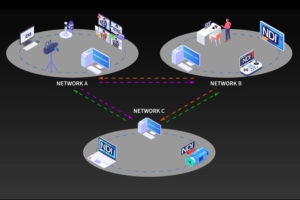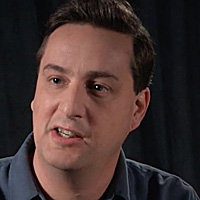
Boosted By COVID, NDI Gains Traction With Broadcasters And Vendors

NDI, the royalty-free IP networking protocol initially created by NewTek in 2016 with the goal of bringing video workflows to the masses, is steadily gaining traction in the broadcast world. It is being used both as an alternative to the more complex ST 2110 uncompressed IP networking standard, and as a way to cost-effectively add new routing capacity to legacy SDI plants.
NDI, which encompasses both device registration and discovery as well as compressed video delivery via one-gigabit Ethernet (GbE) local area networks (LANs), was already popular with “prosumer” customers like corporate video producers and houses of worship when Vizrt acquired NewTek back in April 2019. Since then, NDI has been established as its own business unit within Vizrt Group, alongside Vizrt and NewTek. It has set about licensing its technology to a wide range of broadcast vendors for both hardware and software-based products including cameras, codecs, graphics systems and switchers; NDI executives say there are over three million NDI users today.

A schematic of the NDI Bridge.
NDI has steadily upgraded the protocol, releasing a new version last year, NDI 5, with improved audio and editing support as well as genlock for synchronizing cameras. It has also developed additional tools to support remote collaboration and cloud-based workflows. They include NDI Bridge, which allows an NDI network to connect to any other NDI network over the internet to share multiple sources, or to connect to the public cloud; and NDI Remote, which allows a single NDI source to be brought into a production simply by emailing a link to a remote contributor.
NDI received a significant boost from the COVID-19 pandemic as broadcasters were sent scrambling for quick and easy ways to remotely contribute video and maintain live news production. And the supply chain issues that have slowed shipments of high-end 2110 switches and HD-SDI routers have spurred broadcasters to take a fresh look at relatively inexpensive NDI products as an alternative means of routing signals in their plants.
A Viable Third Option

Karl Paulsen
Diversified CTO Karl Paulsen says that NDI has become a viable third option alongside ST 2110 and 12-gig HD-SDI for broadcasters looking to upgrade their legacy HD-SDI infrastructure. He says that with every new facility Diversified works on, the systems integrator is putting in a “layer of networking” for NDI.
“Whether you’re a small facility or a gigantic facility the scale of someone like ABC or NBC, you’re finding NDI interleaved in here,” Paulsen says. “And that’s not going to go away. I think there’s more promise right now for the future of small-station broadcasting in the NDI world, at least for production.”
Dave Van Hoy, president of systems integrator Advanced Systems Group, admits to not being a big fan of NDI before the pandemic. But circumstances caused him to reevaluate.
“A basic truism is that NDI works in public cloud, and 2110 doesn’t, literally,” Van Hoy says. “So, it really forced us to look and learn about it.”
Advantages Revealed
Besides cloud compatibility, another reason to reevaluate NDI was that some early 2110 routing adopters found those implementations too complex to maintain themselves in the long run, or simply not worth the significant initial investment.

Dave Van Hoy
Van Hoy says his biggest reservation about NDI was the fact it was a compressed networking technology, and he was worried about the impact on picture quality from multiple encodes and decodes in a video workflow. But by running what he calls “full bandwidth” NDI — 1080p/60 HD at 100-150 Mbps versus the NDI/HX flavor aimed at final distribution that compresses the signal down to 20 Mbps or less — he says NDI has solved that problem.
“It’s a mathematically lossless codec that executes in the driver, and therefore you don’t have the generational loss that we’ve experienced with so many codecs over the years,” Van Hoy says.
ASG is currently selling a lot of NDI systems, including installations where NDI serves as either an on-premise or cloud-based routing solution using Sienna ND Processing Engine software from U.K. firm Gallery.
Not For Everyone
Van Hoy is quick to say that NDI isn’t for everyone, and notes that it still lacks some broadcast-specific features like support for end-to-end closed captioning and high dynamic range (HDR). For big networks doing high-volume productions with a lot of streams and different formats like 4K HDR, he thinks 2110 is still the way to go.
But for smaller plants dealing with less inputs, NDI can be a very cost-effective solution for IP routing. The Gallery software that simulates 2110 routing capability costs around $25,000, and it can run on an on-premise COTS server that costs under $10,000. Van Hoy says that by using the “ND PE” software the routing capacity of NDI is significantly expanded and that 256×256 operation can be easily supported.
“The reason is that now you’re not just depending on discovering sources and destinations and having each device direct connect to each other, which is how NDI was originally set up to do,” he says. “Now you’re putting a virtual software router in the middle, so each device no longer has to know about every other device in the network. It only has to know about the router.”
ASG isn’t seeing traditional over-the-air broadcasters deploy NDI across their entire plant yet. Instead, they are limiting it to contribution applications, whether that’s bringing in a remote feed from the field or grabbing the output of an on-premise studio camera or graphics system. Van Hoy expects that to shift as NDI 5 rolls out.
“And we’re seeing it added on to a lot of plants,” he says. “This is very interesting. There are a lot of plants where they have a 280×280 SDI router in place, and rather than rip out that router, when they need to add more capacity, they’ll spin up NDI and run them both. That’s why you see things like the new Bridge NDI [3G Gateway] from AJA becoming such an important product.”
A Bellwether NAB Show
More than 48 vendors exhibited NDI-capable products at April’s NAB Show in Las Vegas, where Vizrt had a dedicated “NDI Pavilion” within its booth to highlight key partners. NDI executives saw this year’s show as a validation of the technology’s rapid growth over the past two years. But even they were surprised by how much support the protocol has received from the vendor community.

Roberto Musso
“Everybody wants to use NDI, and everybody has a plan to use NDI,” says NDI Senior Product Manager Roberto Musso.
A couple of years ago, Musso says, some broadcasters were starting to explore NDI by buying the TriCaster, NewTek’s IP-based live production system, or Viz Vectar Plus, Vizrt’s NDI-native cloud-based switcher. But they were still planning to move to 2110, which replicates the SDI workflow in many ways.
“NDI is much more IT in terms of concept, where 2110 is much more video,” Musso says. “But then when the pandemic happened, almost all of those companies that had built a video production workflow using 2110, they faced a problem where their production was not able to work outside their building.”
Musso says one key to NDI’s appeal is its simplicity, including its unicast architecture and mDNS device discovery and registration, which he compares to finding a printer on a LAN. The other is the codec, which provides high video quality as well as features like native support of alpha channel, which makes it easy to transmit graphics to be overlaid on top of video.
More Support Comes
And since the pandemic, broadcasters have come to realize that a compressed video workflow can be an advantage instead of a negative, he adds.
One new NDI backer is FOR-A, which announced at NAB that all of its products will eventually support the protocol. FOR-A demonstrated a hybrid SDI/IP live production solution with a new NDI-capable production switcher (the HVS-490) and router (the MFR-3100EX) along with NDI graphics from partner ClassX.

Satoshi Kanemura
Satoshi Kanemura, president and COO of FOR-A America, says that NDI has become very popular for production applications among FOR-A’s customers. While he expects major broadcasters will use 2110 for their core routing needs, he said the pandemic had already spurred networks like CBS and NBC to use NDI for remote contribution and editing and new hybrid production workflows. That includes integrating Zoom feeds into a live newscast, using NDI to remotely control pan-tilt-zoom (PTZ) cameras and sending return feeds to the field via NDI.
“It’s simple, low-cost and easy to get into,” Kanemura says.
More fresh NDI support at NAB came from Grass Valley, whose Agile Media Processing Platform (AMPP) cloud-based production and playout software now fully supports NDI. The Grass Valley move wasn’t surprising, as its new CEO Andrew Cross led the development of NDI when he ran NewTek. Cross’ goal then was to bring real-time video to every office building in North America, which is why the protocol was designed to work with the ubiquitous GbE standard.

Andrew Cross
“We believed in connecting computers to do video on computers and connect them on a network,” Cross says. “When I say it was never really designed for broadcast, it was because we saw our primary need was to enable video for everybody.”
Fulfilling that mission of course came with some compromises. Cross says that while NDI’s simplicity is one of its great strengths it can also be a weakness in that it lacks some sophisticated features that broadcasters are used to, such as support for different gamma curves and detailed metrics on dropped frames and jitter. One of his goals at Grass Valley is to “close that gap” between prosumer and broadcast expectations.
“We want to give you the best of both worlds, that allows you to use NDI in a far more broadcast-centric way,” Cross says.
The Route Forward
Musso doesn’t see NDI as a true alternative to 2110 and predicts that many production firms selling content to others will still insist on uncompressed workflows. But he also expects to see more cases of the two IP protocols coexisting together in broadcast plants because there are places where NDI simply makes more sense for customers. He points to Sky Italia: The Italian broadcaster has built three studios that use NDI, including one that is completely software-based, without any impact to the legacy SDI infrastructure in the rest of its plant.

Suso Carillo
“Broadcasters are realizing when it comes to video over IP, 2110 is not a one-size fits all,” adds Suso Carillo, NDI marketing lead for Vizrt Group. “So, what they’re planning is they’re going to use NDI for 60 to 75% of what they have to do, everything that can be compressed, monitoring, etc. And then they’ll use 2110 where they really need a high-end input signal with HDR and that kind of capability.”
But the NDI executives also said the company is working on adding higher-end features that broadcasters have requested, included support for closed captioning and 10-bit HDR, and should be able to provide more detail on their road map later this year. NDI already supports 8-bit 4K and can fit around three streams at a bit rate of around 300 Mbps. Many customers are now running NDI across faster networks like 10-, 20- and even 40-gigabit ethernet, which obviously gives them the capacity to route far more UHD signals.
For his part, Cross says that supporting a wide range of features well, while perhaps not being the best at any, has been key to NDI’s success so far.
“It wasn’t that it does discovery or compression or anything the best, it just blew everything else away,” Cross says. “It was the fact that it did all of them and made them accessible. And in the big picture that is what is always going to win out anyway. What was amazing about it was never one particular thing, but the right combination of things.”
































Comments (0)